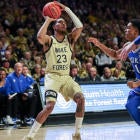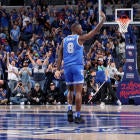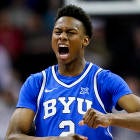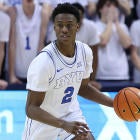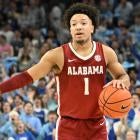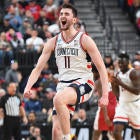May 7, 2015, was the date that changed the direction of Purdue's program.
Boilermakers coach Matt Painter was hosting a recruit on an official visit. He had 12 scholarship players for the upcoming season, meaning one spot was open. This particular recruit looked to be the guy who was going to get that scholarship offer.
And then a twist came. As the recruit was on campus, Painter heard about an in-conference de-commitment from a five-star McDonald's All-American. It was a player Painter was familiar with, sure: He'd only see him play dozens of games and dedicated hundreds of hours and thousands of travel miles to recruiting him. Caleb Swanigan, Mr. Indiana Basketball for 2015, one of the best players to come out of the state in the past decade, was walking back his verbal commitment on Michigan State. He pledged to Tom Izzo's program not even a month prior. But something turned Swanigan, and now Purdue was expected to bring him in.
If Painter could do it, Swanigan would become the first Mr. Basketball to commit to Purdue since Glenn Robinson -- one of the all-time great Boilemakers -- in 1991. That would be six years before Swanigan was born.
Recruiting isn't for the faint of heart. Painter immediately knew the player he was hosting on an official visit (who's since gone on to a mid-major program) couldn't be the priority, not with Swanigan now back on the market. Besides, Purdue was for a time considered the favorite to land Swanigan. What's more, his legal guardian, Roosevelt Barnes, was an alum, someone who was drafted into the NFL out of Purdue in 1982.
It was a hard, perhaps harsh move to make on that recruit, but pretty much any coach trying to keep his job at a power-conference program would have done the same thing. It was the practical move. Less than two weeks after balking on Michigan State, Swanigan swore to Purdue. And now, everything is falling into place for Swanigan, Painter and the program.
If you've missed it, the sophomore big man is putting up numbers we haven't seen at the college basketball level since Tim Duncan was at Wake Forest.
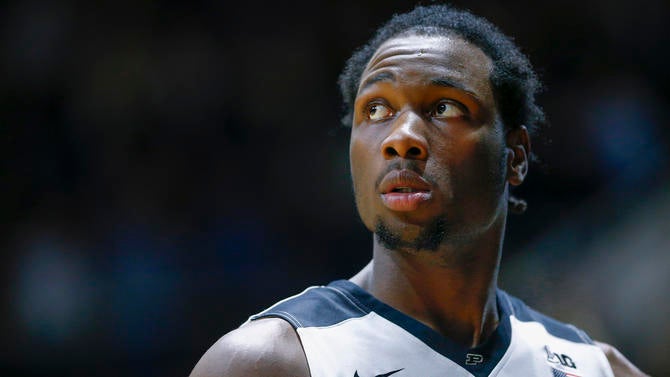
Purdue, which faces an interesting game at Ohio State on Thursday night, is 12-3 and has the realistic goal of winning the Big Ten this season. Swanigan, who is emerging as one of the most dominant two-way players in America, is the catalyst for the program's amelioration. He's averaging 18.5 points, 13.0 rebounds and 2.9 assists. He's also developing a fun and unusual habit of accruing 20-20 games. The 19-year-old already has four games wherein he's scored at least 20 points and grabbed 20 rebounds, the most recent a 28-22 effort against Minnesota on Sunday.
His stats are flirting with the cartoonish, in terms of modern college hoops. Seven times this season a player has had a 20-20 game -- Swanigan has four of them, and the modern record is in sight. The most 20-20 games in a season since 1994 is six by Santa Clara's John Bryant in 2008-09.
Swanigan has also had a 20-20-5 (assists) game, doing that in Purdue's season-opener. The only other players in the past decade to go 20-20-5: LSU's Ben Simmons and Oklahoma's Blake Griffin. Both of them went No. 1 in the draft.
Against Norfolk State on Dec. 21, Swanigan became the first player this season to have a 30-20-2 game; there have been just six 30-20-2 games in college basketball in the past five-plus seasons. The only player aside from Swanigan to do it and come from a major conference: Kansas' Thomas Robinson. He was a top-five NBA pick.
Swanigan also had consecutive 20-20 games, on Dec. 19 and 21, and thus became the third player in the past two decades (Griffin and Hofstra's Rokas Gustys) to achieve the feat. Swanigan's four 20-20 games doubles all 20-20 games by all other Big Ten players combined since the mid-1990s.
"Losing [NBA pick A.J. Hammons] and things like that, we were going to need a guy down there to pick up the load," Swanigan said. "Defensively it's been a lot easier for me, just going through it before and knowing the level you have to play at."
If Swanigan keeps on pace with an 18/13/2 average, he'll join Griffin and Tim Duncan as the only players in the past 23 seasons to finish a season with that average. Going for 18 and 13 might not seem monumental, but averaging 13 rebounds is no longer common at the college level; he's going to crush Purdue's single-season rebound record (352) this year. The guy who holds the record is Joe Barry Carroll -- also a former No. 1 pick. Based on a plausible 35-game season for Purdue, Swanigan is tracking to be the second college basketball player in the past 20 seasons to score 600 points, grab 400 rebounds and dish 100 assists in one season.
Fifty and 60 years ago, a handful of players put up 30-30 games, but those days are long gone. So when you see a college guy come along and start dropping 20-20 with ease, it makes you pause and appreciate him even more.
If you're wondering how he compares to the aforementioned Glenn Robinson, the Big Dog played two years at Purdue and averaged a dominating 27.5 points, 1.9 assists, and on the boards? Nearly 10 per game. That's good, but he was not quite the rebounding force Swanigan is proving to be. Swanigan is averaging more defensive rebounds now (9.9) than Robinson's total rebounds average (9.7).
Swanigan's 12 double-doubles are tops in the country, as is his defensive rebounds clip. He snares caroms on 34 percent of Purdue's defensive possessions, which is a higher rate than any player on any power-conference team (by far) in the history of KenPom.com's database.
All this adds up to an All-American campaign and a clear-cut top-five candidate for national Player of the Year to this point. No one has averaged 15 or more rebounds in a season in Division I men's basketball since 1980. Swanigan might do it.

Though Purdue's been fairly steady, on a national level it hasn't been a must-watch program for most of Painter's tenure. Nevertheless, since he got there in 2005, the Boilers have made eight NCAA Tournaments and will go to their ninth this season. Hammons, a traditional 7-foot center, was a good player in recent years, and the Robbie Hummel-E'Twaun Moore-JaJuan Johnson teams of the late-aughts were the best Purdue teams Painter's ever had.
But this group has become so watchable because Swanigan has turned into a stat monster, and on a certain level, it's captivating to see a guy landlord around the rim. What makes Purdue different is Swanigan can play the 4 or the 5, and so he goes "small" when the 7-foot-2 spruce tree that is Isaac Haas is on the floor. Swanigan is a four-level threat: he can maneuver in the post, is confident from mid-range (59 percent on all his 2s), has foul-shooting ability (77 percent) and is a 41-percent 3-point shooter.
"I feel comfortable on the perimeter. I feel comfortable on all three levels on the floor and I try to make the right basketball decision on every single play," Swanigan said.
He shoots 3s but is selective about it, having taken just 27 this season. Swanigan leads the team in shots but is still efficient in doing so (a solid 117.5 offensive rating). He allows Purdue to have flexibility in its offense.
"He's very good at playing off other people," Painter said. "He's always able to pass the basketball. He's clearly aware of double teams."
His overall defense has been markedly better, too. When he's guarding a man one-on-one, opponents are shooting 20 percent outside of the paint against him, according to Purdue's statistics. Teams might have a "plan," but he's going to win more caroms than not, and if Haas is on the floor, then you've got to worry about Swanigan on the perimeter or in the high post 10 seconds later. Swanigan said he can feel the way teams are scheming against him differently, but nothing anyone can do is stopping him.
Plus, Purdue's able to space itself well with shooters -- and Swanigan. That brings opposing bigs out with him. The Boilermakers are flirting with offensive heights not seen in almost two decades at the program. The team's gone for 80 or more points in five straight games, and if it hits 80 against Ohio State on Thursday, it'll be the first time since 1997 Purdue's done it six straight times. Purdue's also won nine games by 20 or more points. The only teams to win more games by 20-plus? Sixth-ranked Kentucky and seventh-ranked West Virginia.
Swanigan had a really nice freshman season (10.2 points, 8.3 rebounds). He was one of the 20 best first-year players in America last season, but that wasn't good enough to warrant being a one-and-done guy. There was never a real thought he'd go to the NBA.
"He's a very intelligent person but he's also guarded," Painter said. "He's not going to open up to just anyone. With that, he's very business-like for a young person. He's going to shoot extra, he's going to lift extra, he's going to come and watch film. He's done a lot of things a lot of big-bodied guys won't do. He's made some sacrifices that are very hard to do, in terms of lifting, running extra -- during the season -- and there's already enough demands in the season."
For someone as big and naturally gifted at basketball as Swanigan is, the dividends have paid off this year because he's committed to consistency and is as aggressive crashing the offensive glass as he is hungry on the other end.
"I've always prided myself on rebounding, trying to be in the best shape as possible," he said.
His workout regimen is evidence of it. In the fall semester, Swanigan had only two in-person classes to attend, the rest online. So because of this, he spent more time working out than anything else. Two hours of getting up shots, an hour of lifting, an hour's worth of practice, and post-practice workouts were common as well. Swanigan, who is 6-foot-9 and between 245 and 250 pounds, is now down from 13 to 10 percent body fat.
"The biggest jump for him as been a continual improvement of his body, and I think that allows him to have more energy, to play harder," Painter said. "He's really doing a good job of trying to literally go after every rebound, sprint back on defense every time."
He does speed lifting and unconventional weight training. This has helped him get off the ground quicker. He squats and does bench press, but not as much as most others on the team. There's been an emphasis on working auxiliary muscles; getting him stronger where he can't even feel his strength. He's improved his lift speed and hip mobility in big ways since stepped on campus 18 months ago. He no longer struggles to pick up his feet. His natural running motion is now ... natural.
Most impressively, Swanigan is experienced but young for his age, so to speak. He should be a freshman. In 2014, he reclassified to the class of 2015, moving ahead his progress for a year. This mammoth season combined with his young age has taken him from late-second-round prospect he was last year to a guy who could put himself into the first round this year.
"He's showing he can play a role at that level," Painter said. "Sometimes guys don't like hearing that, but guys playing roles [the] past four or five years in the NBA are now making $10-12 million doing it."
Swanigan's aware of how good he's been, but he refuses to say he's the best player in the Big Ten or anything like that.
"It's one of those things where it will be really special if you can add winning to it, to go to a Final Four," he said. "In the moment it won't be as important. ... I feel like we can win the Big Ten just because of what we have this year. Indiana caught fire last year, won a couple of games and just kept rolling. I feel like I'm the best player for my team. I fit well for where I'm at. It's just the spot I'm in. ... I don't want to speak for anyone else."
He doesn't have to. Swanigan has by far been the best player in the Big Ten this season, and if this keeps up, he'll wind up having one of the best seasons in the history of the conference.














